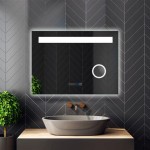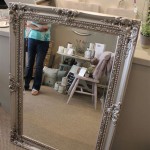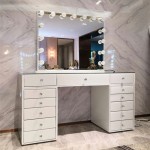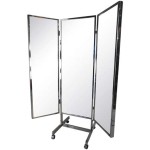What To Use To Hang a Heavy Mirror
Hanging a heavy mirror requires careful consideration of the wall type and the mirror's weight to ensure secure and safe installation. Choosing the appropriate hanging hardware is crucial to prevent damage to the wall and avoid potential hazards from a falling mirror. This article will explore various options available for hanging heavy mirrors, outlining their strengths, limitations, and best use cases.
Understanding Weight Limits and Wall Types
Before selecting hanging hardware, accurately determine the mirror's weight. Bathroom scales can be used for smaller mirrors, while heavier mirrors might require specialized scales. Knowing the precise weight allows for the selection of hardware with an appropriate weight capacity.
Wall type also plays a critical role. Drywall is common but offers less inherent strength than a stud wall. Heavy mirrors should ideally be hung on wall studs whenever possible. Specialized anchors are necessary for drywall installations, especially for heavier mirrors. Brick and concrete walls require different mounting hardware, such as masonry screws or concrete anchors.
Heavy-Duty Picture Hangers
Heavy-duty picture hangers are designed for heavier items and often utilize multiple nails or angled hooks for added strength. They are generally suitable for lighter, heavier mirrors on stud walls. Carefully check the weight limits specified on the packaging to ensure they are appropriate for the mirror's weight. These hangers are typically easy to install and readily available at hardware stores.
D-Rings and Wire
D-rings attached to the back of the mirror combined with heavy-duty picture wire offer a robust hanging method, especially when used in conjunction with D-ring hangers installed on the wall. The weight is distributed across the wire, reducing stress on any single point. This method is suitable for medium to heavy mirrors and can be used on both stud walls and drywall with appropriate anchors.
J-Hooks
J-hooks are metal hooks designed for heavier items. Larger J-hooks, often used for heavier mirrors and pictures, provide a secure hanging solution when installed directly into wall studs. They offer a simple and straightforward installation process and provide excellent weight-bearing capacity.
French Cleats
A French cleat system consists of two interlocking pieces of wood, one attached to the wall and the other to the back of the mirror. This system distributes the weight evenly across a wider surface area, making it a good option for larger, heavier mirrors. French cleats offer exceptional strength and stability, particularly suitable for very heavy mirrors or when hanging on drywall where finding studs might be challenging.
Toggle Bolts
Toggle bolts are particularly effective for hanging heavy objects on drywall where studs are not accessible. They work by expanding behind the drywall, creating a secure anchor point. It is crucial to select toggle bolts rated for the weight of the mirror. While effective, toggle bolts can be more challenging to install compared to some other methods.
Molly Bolts
Similar to toggle bolts, molly bolts offer a strong anchoring solution for drywall. They create a firm grip by expanding behind the drywall when tightened. Molly bolts are suitable for heavy mirrors and come in various sizes with different weight capacities. They are generally easier to install than toggle bolts and provide a reliable hold.
Mirror Mounting Clips
Mirror mounting clips are specifically designed for securing mirrors to walls. These clips typically come in sets and are installed on the wall, gripping the edges of the mirror. Some clips are adjustable, allowing for minor adjustments after installation. They are generally suitable for medium to heavy mirrors and can be used on various wall types with appropriate anchors.
Adhesive Options
While adhesive options exist for hanging mirrors, they are generally not recommended for heavy mirrors. The weight of the mirror can exceed the adhesive's bonding strength, posing a risk of the mirror falling and causing damage or injury. Adhesives are better suited for lightweight decorative mirrors.
Safety Considerations
Regardless of the chosen hanging method, always prioritize safety. Use appropriate safety equipment, such as safety glasses and gloves, during installation. Ensure the chosen hardware is rated for the mirror's weight and the wall type. When in doubt, consulting a professional handyman is always recommended, especially for exceptionally heavy or large mirrors.
Choosing the Right Anchors for Drywall
When hanging a heavy mirror on drywall, selecting the correct anchor is crucial. Plastic anchors are suitable for lighter weights, while heavier mirrors necessitate sturdier anchors like toggle bolts or molly bolts. Consider the weight of the mirror and consult the anchor packaging for weight capacity information to ensure a secure installation.
Ensuring Proper Installation
Accurate measurements and careful placement of the hanging hardware are essential for a successful installation. Use a level to ensure the mirror hangs straight. For heavier mirrors, it can be helpful to have an assistant to help with positioning and securing the mirror during installation.

How To Hang A Heavy Mirror C R F T

How To Hang A Large Or Heavy Mirror

How To Hang A Heavy Mirror

How To Hang A Heavy Mirror

How To Hang Something Heavy Like A Pro Calling It Home

How To Hang A Heavy Mirror With Pictures Wikihow

How To Hang A Heavy Mirror

A Better Way To Hang Heavy Mirror Hanging Pictures

Heavy Picture Mirror Hanging Kit 50 Kg

How To Hang A Heavy Mirror C R F T








